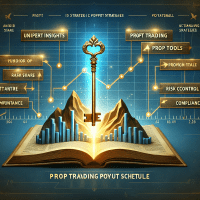Proven Prop Trading Withdrawal Process: Advanced Guide
In the intricate world of prop trading, mastering the withdrawal process is as crucial as developing a robust trading strategy. This guide provides experienced traders and aspiring professionals with detailed insights into ensuring swift, compliant, and efficient profit withdrawals while addressing advanced backtesting techniques and regulatory frameworks.
Understanding the Prop Trading Withdrawal Process
The prop trading withdrawal process involves several key steps from profit realization, compliance checks, and host firm rules to quick payment processing. Traders must be aware of distinct payout methods, minimum withdrawal amounts, and processing times imposed by proprietary trading firms.
Key Steps and Industry Standards
- Profit Realization: Ensuring that the strategy’s gains are in line with firm risk management standards.
- Withdrawal Criteria: Meeting minimum thresholds and adhering to proprietary firm agreements.
- Compliance Checks: Adhering to MiFID II, NFA rules, and ESMA guidelines, which vary by jurisdiction.
- Processing Times: Understanding the typical payout schedule and expected delays.
Proprietary trading firms frequently update their guidelines. A thorough review of payout rules ensures you stay abreast of regulatory requirements while safeguarding your profits.

Comprehensive Backtesting for Strategic Withdrawals
An integral part of the prop trading journey is ensuring that your trading strategies are rigorously backtested. Advanced backtesting techniques help to optimize strategies before live deployment while integrating forward testing for real-time adjustments.
Advanced Backtesting Pitfalls and How to Mitigate Them
Common Pitfalls: Overfitting, survivorship bias, look-ahead bias, and data snooping can distort strategy performance. Mitigating these requires:
- Implementing walk-forward optimization to simulate market conditions.
- Maintaining separate in-sample and out-of-sample data sets.
- Using high-quality tick data to adjust strategies for real-time volatility.
Expert Guidance: Integrate automated parameter optimization tools with platforms like TradingView, MetaTrader 5, or NinjaTrader to generate comprehensive reports including critical metrics such as Sharpe ratios, drawdown statistics, and profit factor calculations.
Case Study: Overcoming Backtesting Challenges in a Prop Firm
Consider a mid-sized prop trading firm that faced challenges in optimizing their short-term scalping strategies. They experienced frequent overfitting due to reliance on limited historical data. By adopting a walk-forward analysis approach with out-of-sample testing, they significantly improved their iteration times and reduced maximum drawdown by 20%. This adjustment not only streamlined their profit withdrawal process but also enhanced compliance with internal risk management thresholds.
Tool Comparisons for Automated Backtesting and Prop Trading
Automated backtesting tools are indispensable for prop traders looking to streamline their withdrawal process workflows. Here, we compare top tools based on advanced features and practical applications:
| Tool | Backtesting Features | Data Quality & Integration | Pricing & Use Cases |
|---|---|---|---|
| TradingView | Vectorized backtesting, event-driven approaches, commission modeling | Historical data depth across various assets; API integrations | Freemium tiers with paid upgrades; ideal for both retail and firm-level analysis |
| MetaTrader 5 | Robust MQL5 coding for automated script testing, strategy optimizer | Extensive broker integrations with real-time data feeds; global indices and FX | Free platform with broker-specific agreements; scalable for prop firms |
| NinjaTrader | Advanced C# based strategy testing with stress analysis features | Supports multi-asset classes with sophisticated API access | Subscription-based; suitable for institutional traders and prop firms |
This comparative analysis helps traders align their choice of tool with the specific demands of prop trading withdrawal processes and overall strategy robustness.
Integrating Automated Backtesting with Live Trading
Before executing live trades, prop trading firms should integrate backtesting results with paper trading tests. For example, a Python algorithm using Backtrader can be structured as follows:
import backtrader as bt
class TestStrategy(bt.Strategy):
def __init__(self):
self.dataclose = self.datas[0].close
def next(self):
if self.dataclose[0] < self.dataclose[-1]:
self.buy()
cerebro = bt.Cerebro()
cerebro.addstrategy(TestStrategy)
# Add data feed, commission settings, and run backtest
cerebro.run()
This snippet ensures that strategy parameters are fine-tuned before deploying with real profits, reducing risks and aligning with firm withdrawal rules.

Risk Management and Regulatory Compliance
In any prop trading environment, control over risk is paramount. Effective risk management not only protects capital but also enhances the efficiency of the withdrawal process. Firms must consider risk ratios such as Sharpe ratios and maximum drawdown thresholds in their assessment frameworks.
Compliance Best Practices
Follow regulatory requirements such as MiFID II, ESMA, and NFA rules that directly impact profit withdrawal processes. Regular internal audits and compliance checks should be integrated into your trading frameworks to ensure smooth payouts and prevent potential legal issues.
Internal Link Recommendations
For further reading on risk management strategies in proprietary trading, check out our article on Advanced Prop Trading Strategies and explore how robust risk management can transform your trading outcomes. Additionally, our insights on Prop Trading Risk Management provide crucial guidance on regulatory compliance and practical implementation.
Pro Tips and Industry Insights
Pro Tip: Always simulate multiple market scenarios using walk-forward and stress testing to validate the robustness of your strategy. This process is critical, especially when dealing with large sums involved in prop trading withdrawals.
Conclusion and Next Steps
The prop trading withdrawal process is a complex yet manageable aspect of the broader trading strategy when armed with the right tools and knowledge. By integrating advanced backtesting techniques, ranging from walk-forward optimization to automated report generation, firms can enhance strategy performance and ensure timely, error-free payouts.
For those looking to take their prop trading operations to the next level, we recommend downloading our comprehensive Risk Management Checklist. This checklist outlines key parameters such as commission handling, drawdown thresholds, and backtesting best practices, providing you with an actionable framework to further streamline your trading and withdrawal processes.
Ready to optimize your prop trading withdrawal process? Join our upcoming webinar on advanced backtesting techniques and risk management to gain deeper insights and practical tools that can transform your trading approach.







